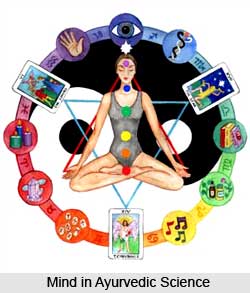 Ashtang Ayurveda is a unique health care system that insists on a proper lifestyle in order to maintain perfect equilibrium and harmony in the human body. The scope of Ayurveda extends from the most sublime spiritual values to the most concrete material manifestations.
Ashtang Ayurveda is a unique health care system that insists on a proper lifestyle in order to maintain perfect equilibrium and harmony in the human body. The scope of Ayurveda extends from the most sublime spiritual values to the most concrete material manifestations.
The Ayurvedic practitioners believe that life is the product of an intricate functional coordination between the soul (Atma), the mind (Mana), the senses (Indriya) and the body (Sharira). These are associated with the five panchamahabhootas or the five supreme powers that constitute the body structure of each individual, called prakriti. The proper functioning of the prakriti depends upon a balance between the three physical energies - Vata, Pitta, Kapha and the three energies of the mind - Satwa, Rajas, Tamas.
Human beings have the tendency to give prime importance to the physical body, which is evident before the eyes. But bounded by the physical structure and yet boundless in its action is the mind, which regulates our thought processes and also enables us to perform our daily activities such as respiration, digestion, circulation and elimination. The mind and the body assisted by the senses, which act as information gatherers, together work in unison to maintain our physiological structure.
Through centuries of keen observation, ancient ayurvedic practitioners were able to find out considerable links between celestial movements and human behaviour. They concluded that the mind is in fact a microcosm of the entire universe. On the basis of this Ayurveda defines three fundamental `gunas` or qualities that manipulate everything that happens in the universe at a greater level and the human mind at a smaller level. These three gunas namely, Satwa, Rajas and Tamas have the potential to harmonise as well as destroy our lives. Just as the three doshas determine the body type, the three qualities of the mind regulate a person`s character, conviction and perception. According to Ayurveda, the psychological constitution of the mind of human beings is dependant upon the comparative dominance of the three gunas.
Satwa is the finest of all the gunas of the mind and is symbolised by the elephant (which is strong, gentle, intelligent and a vegetarian). In the universe it is responsible for creation. Within the human mind, satwa is concerned with the capability of visualizing clearly, thinking rightly and logically, doing good deeds and acting properly without violating the laws of nature. In short, it stimulates the senses and is responsible for the perception of knowledge. Satwa guna is characterized by awareness, delightness, lightness and lucidity. Persons with dominance of satwa guna in their mental constitution are noble, spiritual, pure and free from trouble and are not easily disturbed in life. These people are usually vegetarian. In fact, satwa is the ideal state of the mind.
Rajas, the most active of the gunas of the mind, are associated with motion and stimulation and is symbolised by the tiger (which preys on other animals and is fierce, aggressive, restless and strong). In the universe, this guna is concerned with Maintenance and Nurturing of everything that has been created. The Rajasic guna enables human beings to realise their dreams, to be motivated and to move into action. But an unnecessary abundance of this guna makes a person`s mind restless and anxious. All wants, wishes, ambitions as well as mental discrepancies are a result of the effects of rajas guna.
Tamas is in fact the ability of the mind to finish or complete what Satwa and Rajas created. According to the Ayurvedic concept the jackal (which is cunning, fearful, lazy and survives on food left uneaten by other animals) symbolises the tamasic mind. With respect to the Universe, Tamas stands for Destruction. Tamas Guna characterizes heaviness, produces disturbances in the thought process and other activities of the mind. Hallucinations, apathy, sleepiness, laziness and drowsiness are stimulated by this guna. While some may consider Tamas to be a harmful guna, ayurvedic philosophy says Tamas has its own positive role to play in the entire process of life. This guna aims to free us from what is old and lifeless and we are instigated to move towards what is alive and fresh.
Just as combinations of the three doshas exist for the body, the mind exhibits combinations of satwa, rajas, and tamas. Individuals whose minds are satwic and rajasic are keen on improving themselves through spiritual and holistic measures. The mind with a combination of rajas and tamas tends to overcome lethargy through work and extends to overcome lethargy through work and exercise. The balance of Rajas and Tamas, can be disturbed by stress and desires like irshya (venom), kama (lust), lobha (greed & avarice), bhaya (fear), moha (hallucination), chinta (anxiety & concern) and krodha (anger). Spiritual realisation and attainment of purity and peace helps in the development of satwa, the ideal state of the mind.
Summarily, one can say that our mental personality is determined by the dominance of one or more gunas in our mind. Asthanga Ayurveda |suggests various methods by which we can increase the guna of our choice or blend the gunas in equal measures to attain a balanced personality. But our aim should be to attain satwa, the highest condition of the mind that chooses those thoughts and actions, which promote joy.





